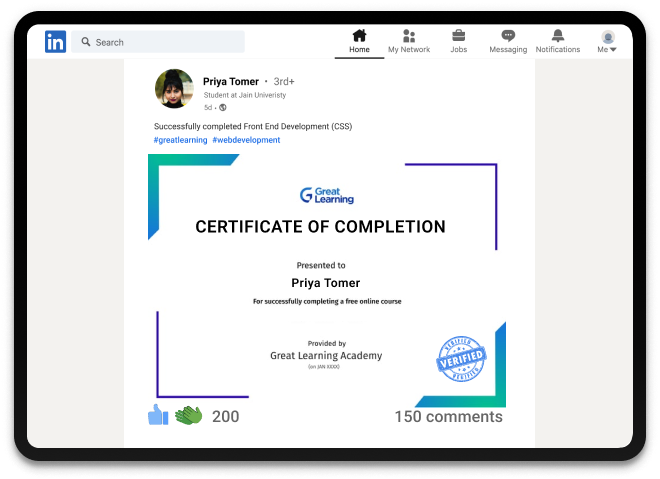Data Structure & Algorithms in Java for Intermediate Level
Learn all about Data Structures and Algorithms in Java, time complexity, recursion, sorting & more.
Instructor:
Mr. Vishwa Mohan
Ratings
Level
Learning hours

Learners
Skills you’ll Learn
About this Free Certificate Course
In this Data Structures and Algorithms in Java course, you will learn what data structures are, the need for data structure, the concept of recursion with examples, and the Tower of Hanoi problem. You will also learn about algorithms using Java, the Time Complexity of the algorithm, the need for sorting algorithms, different types of sorting algorithms, such as Bubble Sort, Quick Sort, Merge Sort, and Insertion Sort.
Great Learning and several well-established universities across India have formed a collaboration to design numerous courses in the Software Development domain. Apply to the top-rated Software Development Online Courses in India to develop advanced software development skills and become a professional software developer. On successful completion of the course, you will be awarded an Advanced, Postgraduate, or Degree Certification in the software engineering online course.
Course Outline
A data structure is a method of arranging data to be used effectively. This module focuses on introducing you to Data Structures.
Data Structures are the backbone of any programming language. This module explains the significance of Data Structures.
This module introduces you to the algorithm and its role in coding.
Time Complexity represents the number of times a statement gets executed. This module explains time and space complexity, and you will learn to find algorithms' time and space complexity.
This module gives you a better understanding of time complexity with the help of the code example.
Our course instructor

Mr. Vishwa Mohan
Sr. Software Engineer, Ex-Walmart, Ex- Paypal, IIT-BHU Alumnus
A Software engineer with 9+ years of experience working in major product companies like Walmart, Paypal, Oracle, etc. He also has a passion for mentoring students and helping professionals crack their dream jobs in Software Engineering.
Success stories
Can Great Learning Academy courses help your career? Our learners tell us how.And thousands more such success stories..
Frequently Asked Questions
What is a data structure algorithm?
A data structure is an effective way in which data can be stored on a computer. The data structure is termed as a specialized format that has a named storage location where we can easily organize, process, retrieve, and store data.
An algorithm is a set of instructions, or you can say it is a step-by-step process that involves the instructions for solving logical and mathematical problems.
Can I use Java for data structures?
Yes, we can use Java for data structures because when you use Java, you will optimize your data structure for better performance.
Is Java good for data structures and algorithms?
We all know that data structures and algorithms are never language-specific, or you can say that they are not dependent on any language. It is good to use Java for data structure because Java API provides built-in support for common data structures. You don't need to implement these data structures on your own you can directly use them in your program by using Java API.
How do you code data structures in Java?
You can code for data structures in Java by using arrays, linked lists, stacks, queues, heaps, etc.
Can I learn Java Data Structures and Algorithms for free?
Yes, you can! Great Learning Academy offers free online courses and the Data Structures and Algorithms in Java course is free as well as a self-paced course. Once you complete the course, you will also get a free certificate.
Popular Upskilling Programs
Other IT & Software tutorials for you
Data Structure & Algorithms in Java
A data structure is an effective way in which data can be stored on a computer. The data structure is termed as a specialized format that has a named storage location where we can easily organize, process, retrieve, and store data.
An algorithm is a set of instructions, or you can say it is a step-by-step process that involves the instructions for solving logical and mathematical problems.
There are many ways of organizing data in memory, like through arrays, trees, queues, etc. If we talk about data structure, one point should be cleared: it is not a programming language like C++, C, Java, etc. The Data structure is a set of algorithms to use in any programming language to set the data in a structure so that it can be stored in the memory.
Whenever we have to structure the data in memory, we have ‘n’ number of algorithms being proposed simultaneously. And these algorithms are also known as Abstract data types. And these abstract data types have their own set of rules.
There are two types of data structures, and they are as follows-
-
Primitive Data Structure
-
Non- primitive Data Structure
Primitive Data Structure
The primitive data structure consists of int, char, float, double, and pointer. And these data structures hold a single value.
Non-Primitive Data Structure
The non-primitive data structures are of two types which are as follows-
-
Linear data structure
-
Non-linear data structure
Linear Data Structure- It is the arrangement of the data in a sequential manner. The data structures used in the linear data structure are as follows- arrays, linked lists, stacks, and queues.
One of the best things about linear data structure is that one element is connected to only one another element arranged in the linear form.
Non-linear Data Structure- In this data structure, one element is connected to n number of elements. The best examples of non-linear data structures are trees and graphs.
Some more types of data structures are as follows-
Static Data Structure- In this type of data structure, the size of the data is allocated when compilation is done. Hence, the maximum size of the data is fixed in the static data structure.
Dynamic Data Structure- In this type of data structure where the size of the data is allocated during the run time. Hence, the maximum size of the data is flexible in the dynamic data structure.
Operations Performed On Data Structure
Searching-
With the help of data structure, we can very easily search for any element from the group of data.
Sorting-
In the data structure, we can very easily sort the data elements either in ascending order or in descending order.
Insertion-
In the data structure, we can easily insert any element in the data.
Update-
We can update any element in the data group, which means that we can replace the element with any other element from the data group.
Deletion-
In the data structure, we can easily remove or delete any element from the group of data.
Data Structures vs Algorithms
We all know that algorithms are also termed ADT(Abstract Data Type), which uses either arrays or linked lists for implementing data structures. Hence, there is a requirement of some data structure that is only particular for ADT.
The difference between ADT and data structure is that ADT tells us what is to be done, and the data structure tells us how it is to be done.
If we tell this difference in simple terms, ADT is the blueprint, whereas data structure provides the implementation portion.
Advantages Of Data Structure
The advantages of the data structure are as follows-
-
If selecting the data structure for implementing the particular ADT is perfect, it will make your program very efficient in time and space.
-
One of the best advantages of using the data structure is that it provides you with reusability. In simple words, multiple clients or multiple programmers can reuse the data structure.
-
The data structures which an ADT specifies also provide the level of abstraction. As we all know, clients cannot see the internal working of the data structure, so they don't have to worry about the implementation details. All they need is to see the interface.
Dataflow of an Algorithm
The dataflow of an algorithm is -
Problem-
To solve any problem, whether it is a real-world problem or a program-based problem, we need to create a set of instructions. And the set of instructions are called an algorithm.
Algorithm-
An algorithm will be designed to solve any problem that is a step-by-step procedure.
Input-
After the required algorithm is being designed, the next step taken into consideration is desired inputs. It is then provided to the algorithm.
Processing Unit-
The input which is given to the algorithm will now be transferred to the processing unit. After performing some operations on the given input, the desired output will be produced.
Output-
The output is the outcome or the final result of the problem given in the initial stage.
Need of Algorithm
The need of using an algorithm is because-
-
It helps to divide the big problem into small-small steps to solve the problem easily. So, it helps us to understand the concept of scalability.
-
The real-world problems cannot be easily broken into small-small steps. If the problem can break into small-small steps, then we can say that the problem is feasible.
Factors of an Algorithm
-
If the program can be divided into small steps, then the modularity feature is perfectly designed for that problem.
-
One more feature called correctness states that when the inputs are given in the algorithm gives you the desired output. This means that the analysis of the algorithm has been done correctly.
-
An algorithm should always be designed in a very simple manner. This is because whenever there is a need to redefine the algorithm, it can be done in a very easy manner.
-
An algorithm contains the logical steps to solve real-world problems in a very easy way.
-
The algorithm should be designed in such a manner that anyone can easily understand it. This should not be there that only the designer and programmer can understand the algorithm.
-
The algorithm should be extensible, meaning that any other programmer or designer who wants to use your algorithm can use it.
-
The algorithm should be very easy to understand.
-
The algorithm should be robust that means an algorithm should clearly define the problem.
Importance of Algorithm
There are two cases from which we can make out that what is the importance of using an algorithm which is as follows
Theoretical Importance- Whenever there are any real-world problems, it is broken into small-small modules. To break down the problem into small-small modules, we should always know all the theoretical aspects of an algorithm.
Practical Importance- We all know that theoretical knowledge is not useful unless we don't perform it practically. So, there must be a practical implementation of the theoretical aspect.
So, there is the importance of both theoretical and practical aspects of the algorithm.

















































